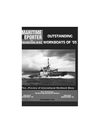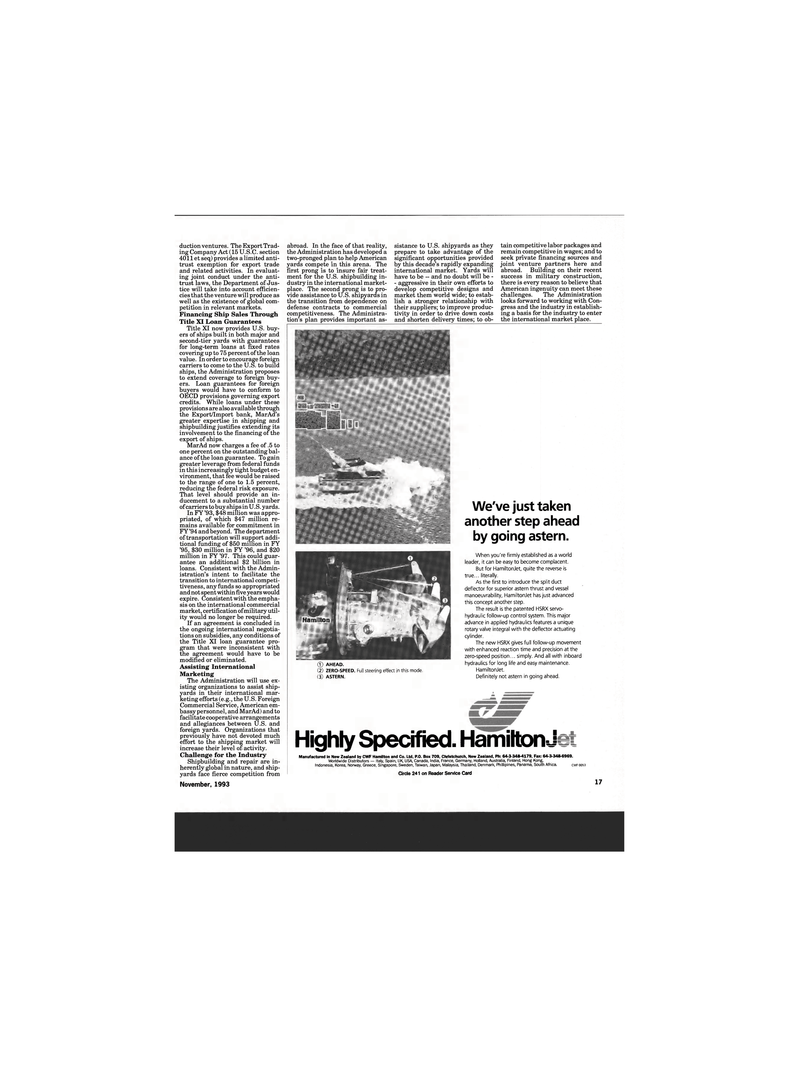
Page 15: of Maritime Reporter Magazine (November 1993)
Read this page in Pdf, Flash or Html5 edition of November 1993 Maritime Reporter Magazine
duction ventures. The Export Trad- ing Company Act (15 U.S.C. section 4011 et seq) provides a limited anti- trust exemption for export trade and related activities. In evaluat- ing joint conduct under the anti- trust laws, the Department of Jus- tice will take into account efficien- cies that the venture will produce as well as the existenqe of global com- petition in relevant markets.
Financing Ship Sales Through
Title XI Loan Guarantees
Title XI now provides U.S. buy- ers of ships built in both major and second-tier yards with guarantees for long-term loans at fixed rates covering up to 75 percent of the loan value. In order to encourage foreign carriers to come to the U.S. to build ships, the Administration proposes to extend coverage to foreign buy- ers. Loan guarantees for foreign buyers would have to conform to
OECD provisions governing export credits. While loans under these provisions are also available through the Export/Import bank, MarAd's greater expertise in shipping and shipbuilding justifies extending its involvement to the financing of the export of ships.
MarAd now charges a fee of .5 to one percent on the outstanding bal- ance of the loan guarantee. To gain greater leverage from federal funds in this increasingly tight budget en- vironment, that fee would be raised to the range of one to 1.5 percent, reducing the federal risk exposure.
That level should provide an in- ducement to a substantial number of carriers to buy ships in U.S. yards.
In FY '93, $48 million was appro- priated, of which $47 million re- mains available for commitment in
FY'94 and beyond. The department of transportation will support addi- tional funding of $50 million in FY '95, $30 million in FY '96, and $20 million in FY '97. This could guar- antee an additional $2 billion in loans. Consistent with the Admin- istration's intent to facilitate the transition to international competi- tiveness, any funds so appropriated and not spent within five years would expire. Consistent with the empha- sis on the international commercial market, certification of military util- ity would no longer be required.
If an agreement is concluded in the ongoing international negotia- tions on subsidies, any conditions of the Title XI loan guarantee pro- gram that were inconsistent with the agreement would have to be modified or eliminated.
Assisting International
Marketing
The Administration will use ex- isting organizations to assist ship- yards in their international mar- keting efforts (e.g., the U.S. Foreign
Commercial Service, American em- bassy personnel, and MarAd) and to facilitate cooperative arrangements and allegiances between U.S. and foreign yards. Organizations that previously have not devoted much effort to the shipping market will increase their level of activity.
Challenge for the Industry
Shipbuilding and repair are in- herently global in nature, and ship- yards face fierce competition from
November, 1993 abroad. In the face of that reality, the Administration has developed a two-pronged plan to help American yards compete in this arena. The first prong is to insure fair treat- ment for the U.S. shipbuilding in- dustry in the international market- place. The second prong is to pro- vide assistance to U.S. shipyards in the transition from dependence on defense contracts to commercial competitiveness. The Administra- tion's plan provides important as- sistance to U.S. shipyards as they prepare to take advantage of the significant opportunities provided by this decade's rapidly expanding international market. Yards will have to be — and no doubt will be - - aggressive in their own efforts to develop competitive designs and market them world wide; to estab- lish a stronger relationship with their suppliers; to improve produc- tivity in order to drive down costs and shorten delivery times; to ob- tain competitive labor packages and remain competitive in wages; and to seek private financing sources and joint venture partners here and abroad. Building on their recent success in military construction, there is every reason to believe that
American ingenuity can meet these challenges. The Administration looks forward to working with Con- gress and the industry in establish- ing a basis for the industry to enter the international market place. • V :
V :: : ' V V: ' /
Hiiihii: © AHEAD. (2) ZERO-SPEED. Full steering effect in this mode. (3) ASTERN.
We've just taken another step ahead by going astern.
When you're firmly established as a world leader, it can be easy to become complacent.
But for HamiltonJet, quite the reverse is true... literally.
As the first to introduce the split duct deflector for superior astern thrust and vessel manoeuvrability, HamiltonJet has just advanced this concept another step.
The result is the patented HSRX servo- hydraulic follow-up control system. This major advance in applied hydraulics features a unique rotary valve integral with the deflector actuating cylinder.
The new HSRX gives full follow-up movement with enhanced reaction time and precision at the zero-speed position... simply. And all with inboard hydraulics for long life and easy maintenance.
HamiltonJet.
Definitely not astern in going ahead.
Highly Specified. Hamilton J
Manufactured In New Zealand by CWF Hamilton and Co. Ltd, P.O. Box 709, Chrlstchurch, New Zealand, Ph: 64-3-348-4179, Fax: 64-3-348-6969.
Worldwide Distributors — Italy, Spain, UK, USA, Canada, India, France, Germany, Holland, Australia, Finland, Hong Kong,
Indonesia, Korea, Norway, Greece, Singapore, Sweden, Taiwan, Japan, Malaysia, Thailand, Denmark, Ftiillipines, Panama, South Africa. CWF 0053
Circle 241 on Reader Service Card 17
Hamilton

 14
14

 16
16
